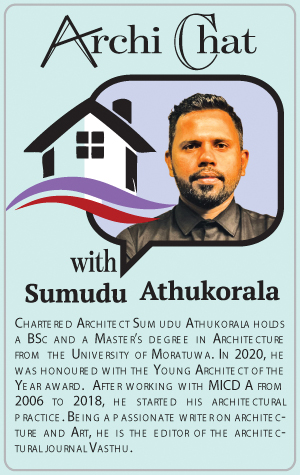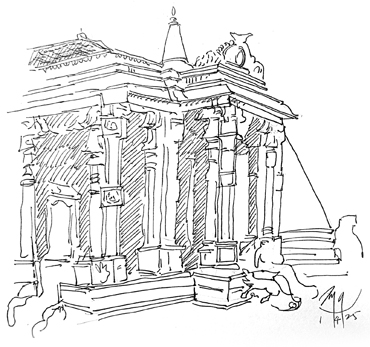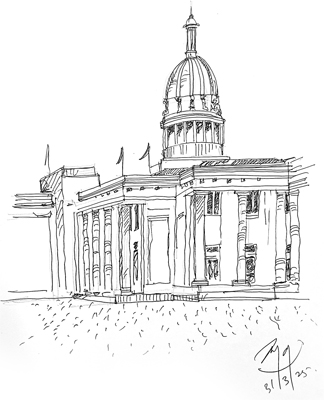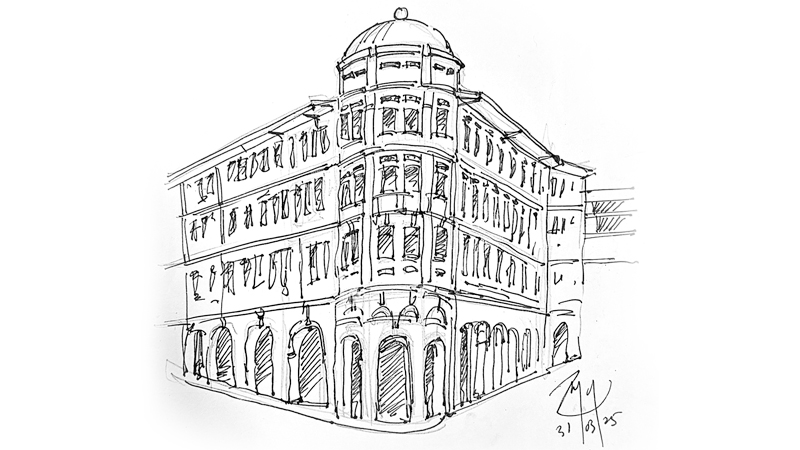Edwards, Reid, and Begg emerged as a distinguished architectural practice in Sri Lanka during the British colonial era, leaving an indelible mark on the country’s architectural landscape. Established in the early 1920s, the firm gained prominence after the Colombo Municipality announced a design competition for a new town hall to be strategically situated in the northeast corner of Viharamahadevi Park, an area renowned for its lush greenery in Cinnamon Gardens.
 At that time, the Public Works Department (PWD) was exclusively responsible for government infrastructure projects; however, they faced limitations as their focus was diverted to the pressing design of a new parliament building. This void allowed for an opportunity that resulted in two international entries from architectural firms based in Allahabad, India, and Singapore. Unfortunately, the competition saw no local representation due to the lack of established architectural practices in Colombo. Ultimately, it was the collaborative effort of S.J. Edwards and R. Booty from Singapore claimed victory with their design.
At that time, the Public Works Department (PWD) was exclusively responsible for government infrastructure projects; however, they faced limitations as their focus was diverted to the pressing design of a new parliament building. This void allowed for an opportunity that resulted in two international entries from architectural firms based in Allahabad, India, and Singapore. Unfortunately, the competition saw no local representation due to the lack of established architectural practices in Colombo. Ultimately, it was the collaborative effort of S.J. Edwards and R. Booty from Singapore claimed victory with their design.
The winning proposal embraced a classical architectural vernacular, characterized by a grand Doric order double-height colonnade that gracefully enveloped the building, enhancing its stately presence. The design incorporated not one, but two square courtyards flanking the main council chamber, an architectural centerpiece that was crowned with a soaring dome, evoking a sense of grandeur. The construction of this iconic structure commenced in 1924, and after an arduous four-year journey, the town hall was finally completed in 1928.
In the aftermath of this commission, S.J. Edwards was compelled to establish a formal practice in Colombo, leading to the establishment of their Colombo office under the name ‘Edwards, Reid, and Booth’ in 1927. The 1930s proved to be a transformative decade for the firm, as they garnered numerous prestigious commissions from both governmental bodies and private clients. The partners of the practice enjoyed an elite lifestyle, living in sumptuous bungalows throughout Colombo and garnering considerable admiration from the local elite.
‘Colonial Classical’

Kelaniya Temple
The architectural creations of Edwards, Reid, and Begg still stand as significant monuments of Colombo today, showcasing their hallmark design language that features robust white masonry walls punctuated by expansive, deep-set windows. Described as ‘Colonial Classical,’ their architecture effectively blended aesthetic grandeur with the tropical comforts of Sri Lanka, exemplified by ample ventilation openings and protective window canopies. Furthermore, their designs occasionally embraced Art Deco and Modernist decorative elements, while remaining anchored in inspiration drawn from traditional and classical Sri Lankan architectural motifs.
Among their notable contributions, the Colombo Town Hall remains an iconic white edifice in the heart of the city, flaunting a distinctive foreign semblance while fully serving its civic purpose. Other significant structures designed by the firm include the striking Gafoor Building in Fort, the chapel of St. Joseph’s College, Galle Face Court flats, the Colombo Art Gallery, various classroom blocks for Ladies’ College, the grandstand at the Colombo Racecourse, the Regal Theatre, and the renowned Mount Lavinia Hotel — each representing their most important public commissions.
The practice undertook the profound rebuilding project of the Kelaniya Temple, alongside influential alterations to the Dalada Maligawa, marking these as some of the most iconic commissions in their portfolio. Notably, it was Reid who spearheaded the design of the Kelaniya Temple, seamlessly integrating numerous Sinhalese architectural features and intricate details into his conception. It’s fascinating to observe that although the architects responsible for the Kelaniya Temple and parts of Dalada Maligawa hailed from foreign backgrounds and were Christian scholars, they exhibited a dedication to infusing elements from Sri Lanka’s rich architectural history into their work.
Concrete replication
Completed in the 1930s, these projects established a critical standard for historical interpretation and significantly influenced subsequent attempts that emerged during the peak of the national movement leading toward Independence.

Town Hall Building
For instance, the Peradeniya University campus —designed by Shirly De Alwis and constructed between 1943 and 1952 — sought to reflect the magnificence of ancient architecture under the guise of a National Style, borrowing aesthetics from historical sources. Similarly, the Independence Memorial in Colombo, conceived by Neville Wynne Jones, serves as a concrete replication of the Audience Hall in Kandy, mimicking the elegance of traditional wooden structures.
These projects serve as cautionary tales about the challenges inherent in establishing a national style that involves inappropriate fusions and the recreation of historical forms utilizing contemporary materials and construction techniques.
In 1935, Booth opted to depart from the practice, with K.G. Begg stepping in as his replacement. This transitional phase was marked by further changes, as Edwards retired in 1936, while Begg resigned in 1939 to serve in the military during the Second World War. The firm’s fortunes waned during the conflict, prompting Reid to embark on an arduous journey to rebuild the practice from scratch after the war’s conclusion. Despite Reid’s passing in 1952, the firm continued its legacy through new partnerships.
Between 1953 and 1957, it undertook the design of the Savoy and Liberty cinemas. During this period, Geoffrey Bawa and Valentine Gunasekera, both former employees who returned to Sri Lanka after earning their Architecture Association diplomas, were welcomed back into the firm. It is significant to note that, at this time, the country had fewer than twenty qualified architects, underscoring the challenges and opportunities that lay ahead for the architectural profession in Sri Lanka.




